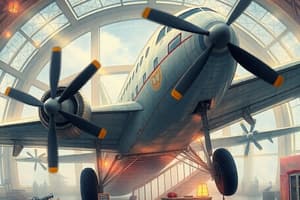Podcast
Questions and Answers
What is the primary purpose of the Minimum Equipment List (MEL)?
What is the primary purpose of the Minimum Equipment List (MEL)?
- To replace required maintenance checks on an aircraft.
- To ensure safe operations during take-off from a base. (correct)
- To permit extended operation of the aircraft with unserviceable items.
- To bypass regulatory requirements related to airworthiness.
What must be ensured before dispatching an aircraft with multiple MEL items inoperative?
What must be ensured before dispatching an aircraft with multiple MEL items inoperative?
- That there is no interrelationship that could degrade safety. (correct)
- That the aircraft has sufficient fuel reserves.
- That the crew is adequately rested for the flight.
- That the items can be fixed at any time during the flight.
Which items are typically excluded from the MEL?
Which items are typically excluded from the MEL?
- Instruments and cockpit displays.
- Emergency equipment and medical supplies.
- Landing gear and flight controls. (correct)
- Galley equipment and passenger convenience equipment. (correct)
What is the suggested action if an MEL item is unserviceable during a flight?
What is the suggested action if an MEL item is unserviceable during a flight?
What should the operator include in the MEL's preamble?
What should the operator include in the MEL's preamble?
What is the role of the Master Minimum Equipment List (MMEL) in framing an MEL?
What is the role of the Master Minimum Equipment List (MMEL) in framing an MEL?
What happens to items not included in the MEL but affecting airworthiness?
What happens to items not included in the MEL but affecting airworthiness?
What does the preamble of the MEL define regarding defects?
What does the preamble of the MEL define regarding defects?
What should an operator consider when customizing their MEL?
What should an operator consider when customizing their MEL?
What is a key factor in ensuring safe aircraft operations with MEL items?
What is a key factor in ensuring safe aircraft operations with MEL items?
Flashcards are hidden until you start studying
Study Notes
Maintenance and Operations Philosophy
- A philosophy exists to ensure safe operations during takeoff from maintenance bases or en-route stops.
- Operators must maintain close operational control to prevent dispatching aircraft with multiple Minimum Equipment List (MEL) items inoperative.
- Assessment of any interrelationships between inoperative systems is crucial to avoid safety degradation or added crew workload.
MEL Guidelines
- MEL is not designed for extended aircraft operation with unserviceable items.
- Repairs for unserviceable MEL items should be made at the nearest station capable of performing the work and must be completed at the flight termination station to avoid potential removals from service.
Exclusions from MEL
- Items affecting airworthiness, such as wings, flight controls, engines, and landing gear, are not included in the MEL.
- Non-essential items, including galley equipment and entertainment systems, that do not impact airworthiness, are also excluded.
Airworthiness Requirements
- All items impacting the aircraft's airworthiness or passenger safety must be operational and are not permitted to be included in the MEL.
Framing the MEL
- The MEL must be framed based on the Master Minimum Equipment List (MMEL) and include the latest revisions approved by the relevant regulatory authority.
- Customization of the MEL should consider operational specifications, aircraft configuration, modification status, and regulatory requirements.
- Deviation from flight manual limitations or emergency procedures is not permitted unless stated otherwise by the regulatory authority or flight manual.
Preamble and Rectification Intervals
- Operators must outline their philosophy for invoking the MEL in the preamble.
- The preamble should also specify defect rectification intervals as defined in the MMEL.
- MEL items are categorized into:
- Category ‘A’: Items requiring repair within the specified time interval in the remarks column.
- Category ‘B’: Items needing repair within three consecutive calendar days, excluding the day of malfunction recording.
Studying That Suits You
Use AI to generate personalized quizzes and flashcards to suit your learning preferences.




